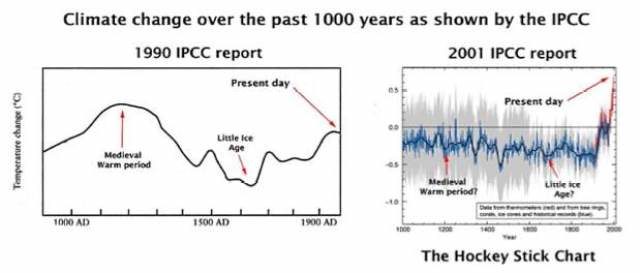The published paper - available in full HERE — sets out its intent:
Climate change is NOT a new phenomenon. The palaeo-climatic studies reveal that during the Pleistocene and Holocene periods several warm and cold periods occurred, resulting in changes of sea level and in climatic processes like the rise and fall of global average temperature and rainfall.
The United Nation's politicizing of global warming/climate change (via the media and summits) has made it difficult to take another look at the subject's scientific and academic status. But in this paper an attempt has been made to examine the complexity of the problem in the light of available facts related to the atmosphere and climate system:
Energy Sources for the Heating of the Atmosphere
The ultimate source of energy for the heating of earth's surface and atmosphere is the Sun.
Out of the total solar radiation that reaches the top of atmosphere, about 49% reaches the earth's surface (insolation). 31% is reflected back to space, while 20% is absorbed by atmosphere.
This shows atmosphere absorbs only 20% of solar radiation directly while earth's surface is the major source of energy for the heating of atmosphere.
Water Vapour is the Single Largest Atmospheric Gas Rather than Carbon Dioxide
Pro human induced global warming scientists exaggerate the contribution of carbon dioxide as a major greenhouse gas in absorbing long wave earth's radiation. The fact is water vapor is the single largest atmospheric greenhouse gas (2% by volume), Carbon dioxide is second (0.0385% by volume).
Water vapor contributes 95% to the greenhouse effect, all other greenhouse gases combined contribute only 5%. Furthermore, the man-made portion of carbon dioxide contributes only 0.117% to the greenhouse effect.
The IPCC does not consider water vapor a greenhouse gas in its reports.
In addition, water vapor absorbs in a much wider band of long wave radiation (4-8 micrometer and 12-70 micrometer bands), whereas Carbon dioxide absorbs in narrow bands (13-16 micrometer) and ozone absorbs in a much smaller narrow band (9-10 micrometer). Thus, water vapor absorbs in a much wider wave length band, it has the single largest greenhouse effect among all the greenhouse gases.
Earth's Temperature Variations During last 1000 years
Earth's temperature was never constant.
Instead, its past temperatures varied in cyclical patterns. Earth's temperatures for the past 1000 years have been constructed on the basis of historical records, measured temperature data and several proxy data (ice core data, tree ring analysis, pollen analysis).
Earth's temperature pattern in the past 1000 years shows two relatively long cycles:
- The Medieval warm period from 950 AD to 1350 AD, followed by:
- The Little Ice Age from 1400 to 1900 AD
Scientific Facts Contradicting IPCC's Claims of Global Warming and Climate Change
There is a large group of scientists who strongly oppose IPCC's claims of global warming caused by human activity.
Some of the contradictions and neglecting factors are discussed further in Prof. S. Akhtar's full paper, which can be downloaded HERE, but I've created a succinct snapshot of the topics below:
Complexity of the Earth's Climate System
Earth's climate system consists of several interactive components — lithosphere (rocks), hydrosphere (water), cryosphere (sphere of ice), biosphere (living organism) and atmosphere (sphere of air). There are several subsystems of these spheres which interact and develop a complex system of climate system of the earth. Therefore, any forecast of climate system based upon selected parameters of stimulated computer model as used by IPCC for future projection and estimation can never give a real and correct picture of global warming/climate change.
Recent Global Warming and Climate Change is because of Natural Factors
IPCC reports were not allowed to consider natural factors of climate change — even though evidences on the basis of ice cores, tree rings and historical data confirm the Medieval Warm Period and Little Ice Age which were caused by natural processes, like these:
- Change in Earth-Sun orbit shape and angle of earth's axis
- Variations in solar radiation and activities, such as flares or sunspots
Urban areas are much warmer than the surrounding open/rural areas because of the building materials, high density of buildings, high rise buildings, large number of vehicles and heat emissions. Since the 1970s, urban areas have grown rapidly in number and size all over the world. Very importantly, almost all the weather stations are located in cities. So rapid growth in urbanization has created a bias toward warmer temperature. This factor was also not considered by the IPCC.
Even more telling, Prof. John Christi, an astrophysics of the university of Albama, studied ground recorded temperature and found temperature is rising while the weather satellite temperature data and air balloon recorded temperature show little change.
Global Distribution of Climatic Stations and Data Bias
Only 100 weather stations existed in 1875, all of which were located in Europe and North America. This number increased to 1,700 in 1975, and since then the number of stations has increased dramatically to 10,000 at present. Therefore, most of the stations did not exist prior to mid -1970s.
Also, the majority of the stations are located on the continents of the northern hemisphere, in the mid-latitudes and in urban areas — meaning our climate data set is biased towards landmass.
Credibility of IPCC is Questioned
A major blow to IPCC credibility came on October 19, 2009 when thousands of documents and emails were leaked out by some computer hackers from the Climate Research Unit (CRU) of UK's East Anglia University. This leak came to be unimaginatively known as Climate Gate.
The documents reveal misconduct of the top IPCC climate scientists in the UK and USA in creating manufactured data about the release of carbon dioxide through burning of fossil fuels and industries causing global warming. Some of the US governmental agencies like US National Climate Data Centre and NASA's Goddard Institute for Space Studies were also involved in data manipulation.
The Hockey Stick Graph
Michael Mann's infamous 'Hockey Stick' graph has two major flaws.
First, it shows that earth's temperatures were below normal for a long period -1000AD to 1970s- then temperatures increasing dramatically since 1980s. And secondly, it also alters the long-accepted Medieval Warm Period (950 AD to 1350AD) so as to seem as colder than originally thought.
It was found out that Mann's graph was drawn on the basis of a very small ring samples (10 out of 85 samples) and by data manipulation and statistical exaggeration.
Despite these shocking revelations, the 'Hockey Stick' is still used in all IPCC reports. Since the IPCC's third report in the 2007, Mann's graph has replaced the original one (which clearly identified the MWP) used in first and second reports — a change strongly criticized by many climate scientists.
Assessments of IPCC about Global Warming Impacts on Sea Level Rise and Glacier Melting are Incorrect and Overstated
According to IPCC reports issued 2007, global mean surface air temp has increased by 0.3C to 0.6C since the late 19th century. As a result of melting of glaciers and polar ice sheets, global sea level has risen by 15 to 20 cm over the past 100 years, and if this trend continues sea level will rise up to 50 to 80 meters by the end of 2100. Low land areas and islands like Maldives will submerge into sea water...
Professor Nelis Axil of Stockholm University, and president of International Organization of Sea level change and coastal evolution, conducted several studies on the beaches of Maldives. He concluded that during last 50 years there has no permanent rise of sea level in the area...
For a read of Prof. Akhtar's full — and published! — paper, click HERE.
Akhtar gained a B.Sc. (Hons) in 1989, M.Sc (Geography) in 1990, and a Ph.D (Urban Geography) in 2004.





[Link]